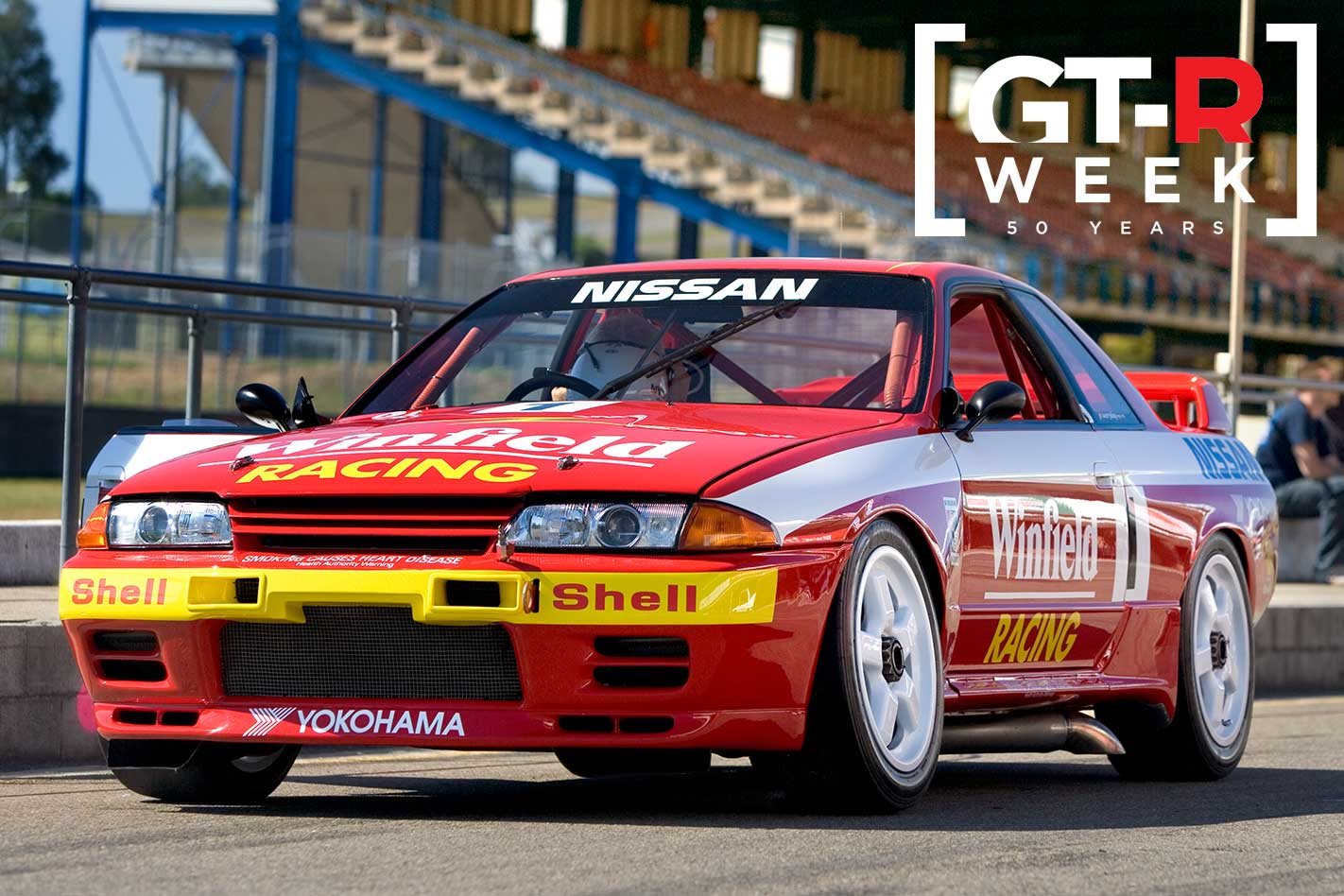If you reckon those Shell V-Power Mustangs are dominant, think again. Nearly 30 years ago, the Group A racing version of the R32 Nissan GT-R was as close to unbeatable as it gets.
It was so good, so technically advanced, it killed the category. Worldwide, homologation icons like the Ford Sierra Cosworth RS500 and BMW M3 Evo just couldn’t compete against the Japanese all-wheel-drive wonder.
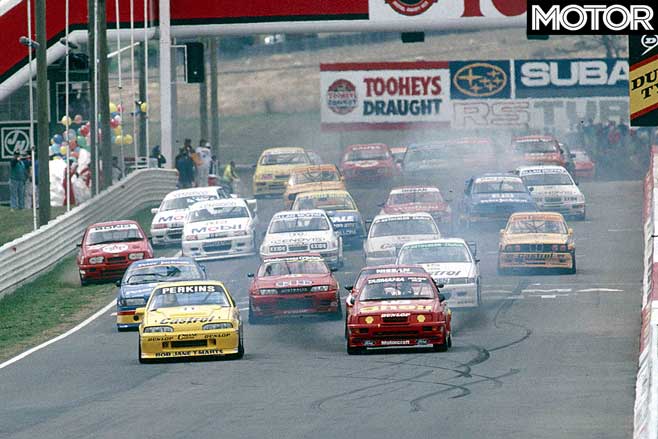
In two years, the car dubbed ‘Godzilla’ – an Aussie sobriquet that went viral globally before the internet era – changed the face of touring car racing forever. No more homologation specials, no more all-singing, all-dancing production-based racers.
Rarely has such a great race car been so vilified. Local fans hated the GT-R and rivals resented it. That enmity resulted in Jim Richards’ immortal line “You’re a bunch of arseholes” to the baying audience as he celebrated his and Mark Skaife’s flood-shortened victory at Bathurst in 1992.
V8 legends Richards and Skaife, guided by acclaimed Nissan team boss Fred Gibson, established the GT-R in Australian motor racing folklore – and infamy – by overwhelming the opposition in ’91/92. Ford folk hero Dick Johnson and his Sierras, the factory backed BMWs and Holden’s game Group A Commodore were eaten alive by Godzilla. But, contrary to popular opinion, the GT-R was a monster to drive.
Alongside the racing program, Nissan Australia – in the final throes of its 25-odd years as a local manufacturer – ADRed the R32 GT-R for limited sale here. At $110,000 – an extraordinary amount back then – the 100 cars proved very slow to move.
Now, of course, Aussie R32s are gold. Nissan Australia recently bought back this red example and it was driven, nostalgically, by Skaife as part of our reminiscence.
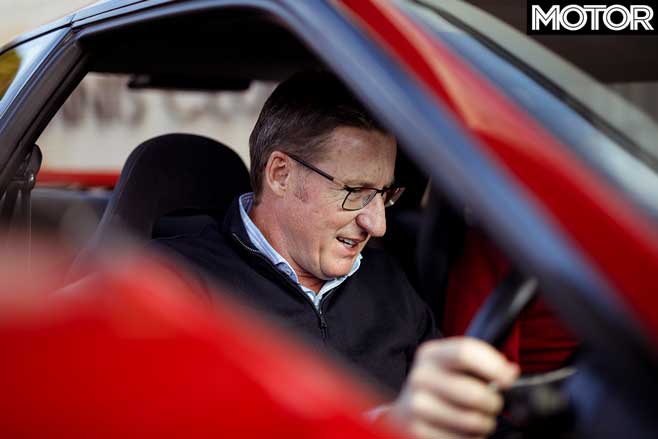
We’ve gathered Skaife, Gibson and former Nissan Oz product planning, design and Special Vehicles boss Paul Beranger at Kooyong Lawn Tennis Club in Melbourne to recount the Godzilla racing tale.
Two things to remember. Introduced in mid-1991, Nissan Australia’s new halo car was a Skyline GT-R. And the Skyline sedan had been the company’s locally made six-cylinder Commodore/Falcon fighter until 1988.
Aside from the Skyline tag, they were unrelated. But the more closely aligned DR30 Skyline RS and HR31 Skyline GTS-R had carried the Nissan flag in Australian Group A from 1986-90. The R32 GT-R took over late in the ’90 season, helping Richards win Nissan’s first Australian Touring Car Championship.
He won the title again in ’91 before Skaife ascended in ’92, with their GT-R monstering Mount Panorama in both years to finally end the Nissan Bathurst quest that had begun in 1981 with the fast but fragile Group C Bluebird Turbo.
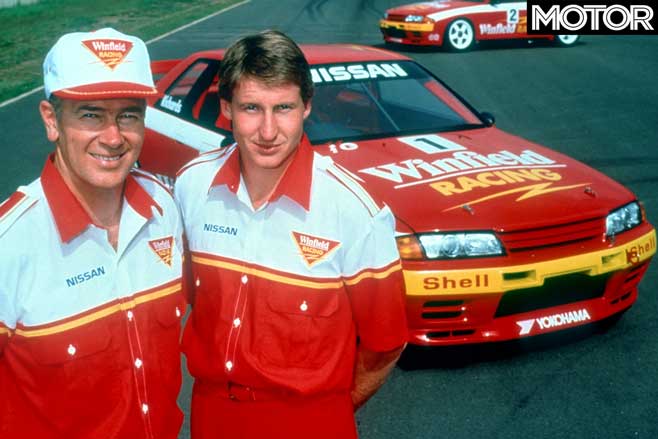
How the R32 Skyline GT-R road car got to Australia has been covered previously in MOTOR’s special 50th-anniversary “GT-R Week” celebration. It was an attempt to directly link the early ’90s racing program with a model actually sold here. All very tenuous and, as it turned out, horrendously expensive exercises for both the road and race versions.
For the racing R32, the Gibson squad had to make a lot of changes to make it competitive locally and contain costs, despite generous factory backing.
“You have to remember that our touring car category in Australia was very competitive, and the thing is, a Japanese-spec race car wouldn’t win here,” Gibson says. “It wouldn’t be quick enough against the Ford Sierras and Holden Commodores. So we had to homologate the parts on it that we wanted on the car with the FIA through CAMS to make the race car a better car, and that took a lot of work.”
Adds Beranger: “Nismo in Japan wasn’t too impressed when we told them we needed to change their pride and joy.”

However, Nismo quickly came on board to help the upstart Aussies get the best out of the Godzilla racer.
“It was a very complex car and the Japanese offered us support to do it, and from the very beginning we had Japanese engineers in Australia,” Beranger says. “And clearly their job was not only to help, but to report back. And, therefore, I believe they were continually explaining to Japan what we were doing.
“Japan wasn’t negative about it – they were offering suggestions – but I think at the same time they became aware and realistic that what we were doing was probably in advance of what they were doing.
Part of the problem was that in Japan they didn’t really have to develop the car because they controlled the formula. The more they developed, the more they had to spend, whereas we had to keep developing, and at every race the car changed. The Japanese were aware of that.”

The Aussie overhaul of the R32 racer was comprehensive, as Gibson explains: “Suspension, wheels, gearbox, clutch, engine… Like cylinder blocks, for example.
“We put an engine on the dyno and cracked the block because of the extra power we were trying to get out of it with a different engine management system. So they had to make special blocks for us. They were good at doing that, but it took time – and money. A lot of money.
“A part of going local was to save money because the Japanese parts were just silly money.
“A competition water pump from Japan was about $15,000 and all they did was change the impeller on it, which we could do here and use the normal water pump. A dog box gearbox was $60,000.
“Nismo were there to make money, whether we were Nissan or not. They still charged an arm and a leg. So we went away from using Nismo stuff.
“The wheels, the suspension, the gearbox were all local. They made the cylinder blocks, but the Electromotive engine management system was done for us in America. We did it all ourselves, which was still very expensive, but not as expensive as getting all the bits from Japan.
“Our budget was huge. We were very fortunate to have good sponsors as well as Nissan Australia.”
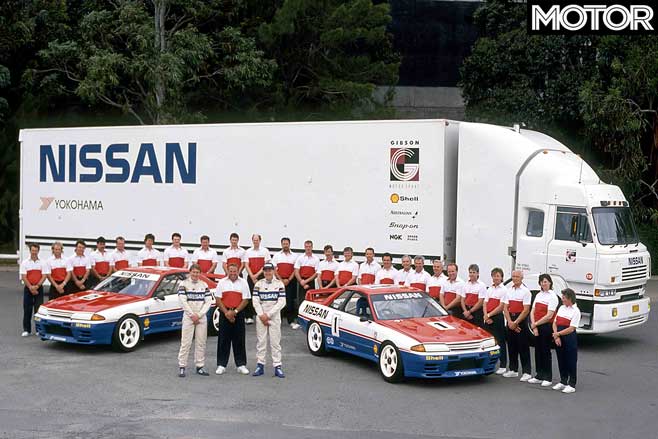
Beranger: “We had no alternative (than to do local development) because we would’ve gone broke quicker if we hadn’t done that. And that caused some angst between us and the Japanese. The Japanese (management) in Australia wanted to know why we weren’t using NISMO parts. We had to show them actual receipts to prove the big difference in cost.
“The problem was that Nismo owned the Group A series in Japan. All the cars were raced with Nismo parts, so it was a closed shop, whereas in Australia, we’d never looked at it that way. We’d always had Fred to do what we needed to.”
By 1992, even Nissan Australia was baulking at the cost and Winfield came on board as sponsor, boosting the factory’s $1 million contribution to a $4 million annual budget. More than a quarter of a century later, that’s a figure most Supercars teams would envy.
“We were struggling when we first did GT-R because we didn’t have enough money to do the job properly,” Gibson reveals. “We were lucky to have cigarette money come along because it was a very expensive car to run.”
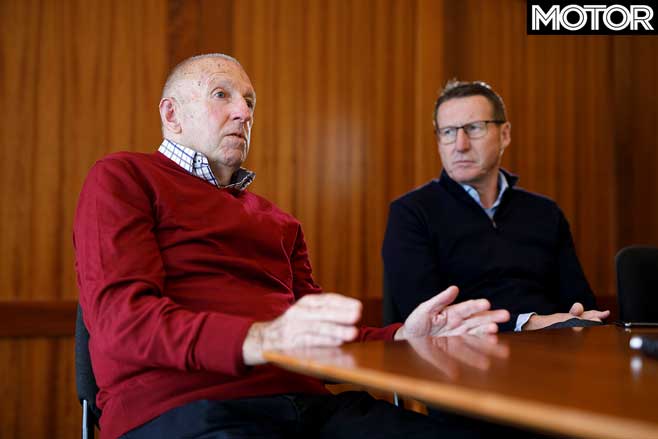
Initially, Gibson was enthused by the on-paper specifications of the forthcoming Group A R32.
“When Paul first told me we were going to have a twin-turbo six-cylinder Skyline, I thought ‘Wow, that’s going to be great’. I expected it to be a V6 twin-turbo,” Gibson says.
“When it lobbed with a straight-six twin turbo, it was pretty rare. One of the problems was that the engine was long and hung out over the front subframe, so the car was front-heavy. If it had been a compact V6, it would have been a rocketship.”
Heavy to begin with, Godzilla’s racing weight was increased from 1350kg to 1500kg as CAMS tried – unsuccessfully – to rein in the ATCC-devouring monster. Following intensive development and refinement, the red rockets were producing 650 horsepower (485kW) in race trim – later reduced to 620 – and, with the boost wound up, 700bhp (520kW) for qualifying, with drive to the four wheels controlled by what was then sophisticated computer management.
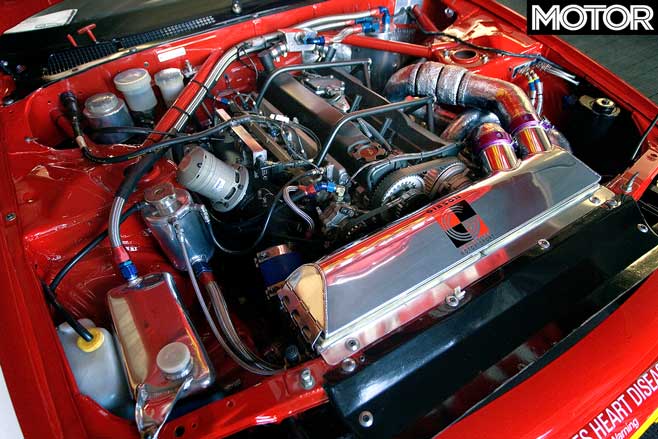
In full flight, both Gibson and Skaife remember that the 2.6-litre twin-turbo straight six “bellowed”.
“It was already a heavy car, but they (CAMS) just kept putting weight on it,” Gibson says, clearly still bitter. “We were handicapped because we built a better mousetrap within the regulations. We did our homologation properly – and that took time and money.
“We became the benchmark for GT-R in the world.”
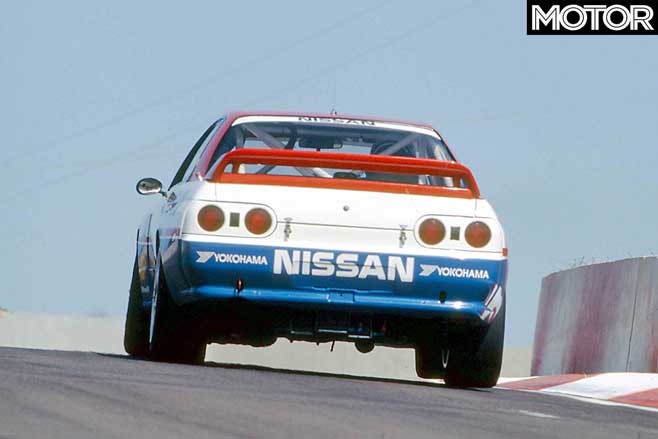
So well developed were the Australian GT-Rs that when Gibson received offers to compete in the Fuji 500 in Japan and the Macau Grand Prix’s Guia touring car race, Nismo vetoed the idea for fear of being upstaged.
Despite the historical myth that the R32 GT-R was unbeatable from the outset, Gibson is adamant it took a lot of intensive local work to capitalise on the car’s inherent advantages.
“It was very unreliable at the start,” Gibson says, shaking his head. “It was a nightmare. A lot of work had to go into the car and we had to develop it. We used a lot of Australian suppliers to help us get it right.”
Godzilla became so dominant that Berganger reveals that even rival teams expressed interest in switching to the four-wheel-drive monster.

“When people realised the GT-R was going to be the gun car, they knocked on our door and wanted to run GT-Rs – until we told them the budget,” he recalls. “Two things killed that (customer cars) – one was the budget required, and the second was that they would have to deal through Fred because Nismo didn’t want to deal with independent teams in Australia. They said they were happy to supply through Gibson Motorsport.
“And, motorsport being what it is, those people always believed they’d get second-rate service because Fred would be the works team and the rest would get hand-me-downs. There wasn’t enough money in it for those team owners plus the development costs.
“Fred was successful, of course, with the GIO car which ran under him, but the rest of the people – and I mean oil company-sponsored teams – actually knocked on my door and asked us if they could be part of GT-R. Ultimately they walked away from it because of the cost of doing it, even compared with a Sierra Cosworth RS500.”
According to Mark Skaife, while the R32 GT-R racer was the class of the field, it still wasn’t easy for he or Richo to extract its full performance once it was fully sorted.
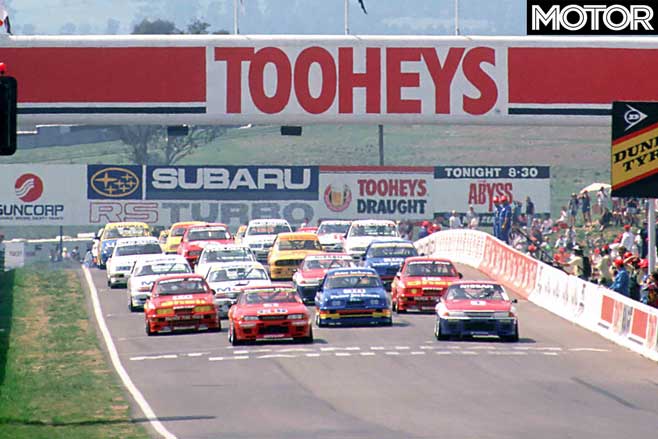
“It was the most technically advanced touring car of the day by a long margin,” Skaife says. “But it was hard to drive. Its outright pace was similar to today’s Supercar, but with a smaller tyre and no aero. I mean, it would have had lift.
“And when it was finally handicapped to 1500 kilograms, it was a big, heavy car with small tyres and no aero. It was a real handful. In the slow stuff the car was obviously great, but in the fast stuff it was wild.
“Its big advantage was in the wet, especially at places like Mallala, Amaroo Park and Winton (tight, twisty tracks).
“When it rained, the thing was just a weapon.”
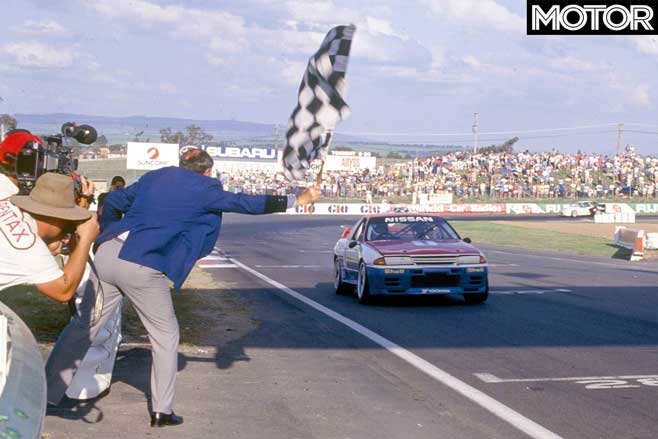
But even in the wet the GT-R couldn’t defy the laws of physics. Richards was on slicks when he crashed while leading Bathurst in ’92, running out of grip in the flooding downpour and triggering the red flag that stopped the race.
In those days, the result was decided by the positions on the lap before the cancellation, handing victory to Richards and Skaife. The controversial finish enraged the fans, who had been incited by Dick Johnson’s claim that he and John Bowe should have been the winners in their second-placed Sierra because they were still actually running when the race was declared.
More than a quarter of a century later, Gibson remains defiant, maintaining the race was in the bag regardless.
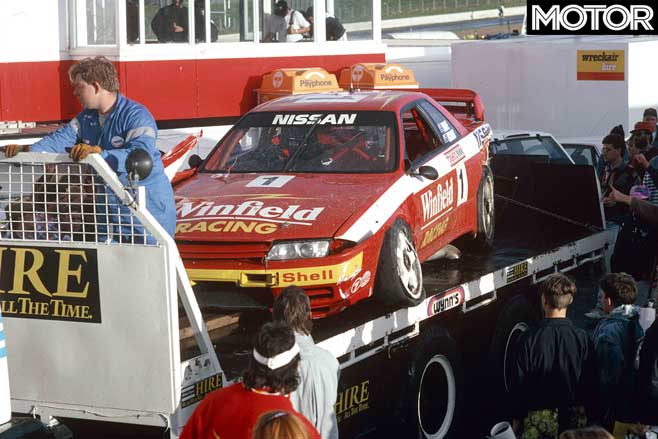
“Didn’t matter,” he scoffs. “We were going to win anyway. We had the best drivers and the best team, and the car was a good car. Simple as that. But the car was a good car because it was developed within the regulations to be a good car.”
Gibson, who won the 1967 Bathurst 500 in a factory Ford Falcon GT – the first for a V8 – starting the arms race that led to the homologation specials that ruled from the late 1960s through the ’70s, rates the R32 GT-R’s success as the highlight of his team management/ownership career.
“Oh, for sure,” he says. “Having the people that engineered the car, designed some of the equipment for the car, was very satisfying. We had to do so much in-house ourselves – the engines and the whole thing. The only thing we didn’t do was the (Australian) Holinger gearbox.
“The rest we did ourselves. We got new things cast and I still have all the old drawings for that. All those things we got done to make it a better car were done because we had good people. The people made the difference.”
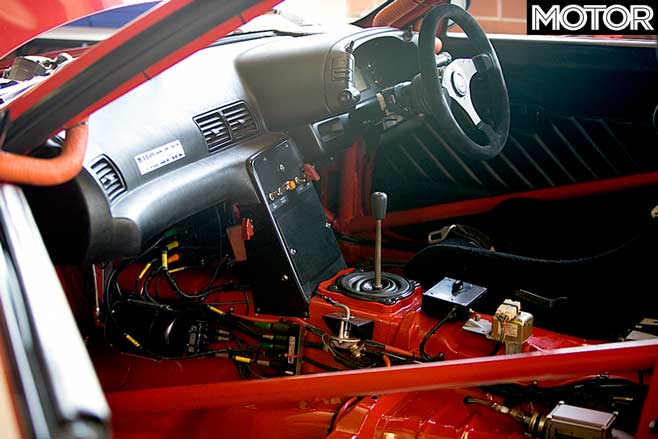
Gibson went on to again win the ATCC with Skaife in a V8 Commodore in 1994 and also the ’99 Bathurst 1000, before a contentious involvement with a Ford factory team established in 2001 to run Holden defector Craig Lowndes.
Skaife made his name in Godzilla amid great controversy and relates the regulatory crackdown as a cautionary tale for the currently dominant DJR Team Penske Mustang team.
“Roger Penske was talking to me in Perth (in early May) about the recent parity issues (that had been suggested for the Mustang) and I said, ‘Well, in the Gibson Motorsport days, when the GT-R won everything, they changed the rules completely, going back to V8 racing the next year’. So we had to change from Nissan to Holden in just three or four months.
“So I said to Roger, ‘If you take your parity debate right down a road of domination, that’s what happens.’”
Winner of five touring car titles and six Bathurst 1000s, Skaife, who has been heavily aligned with Nissan and Holden in his racing career, also remembers the R32 Skyline GT-R road car fondly.
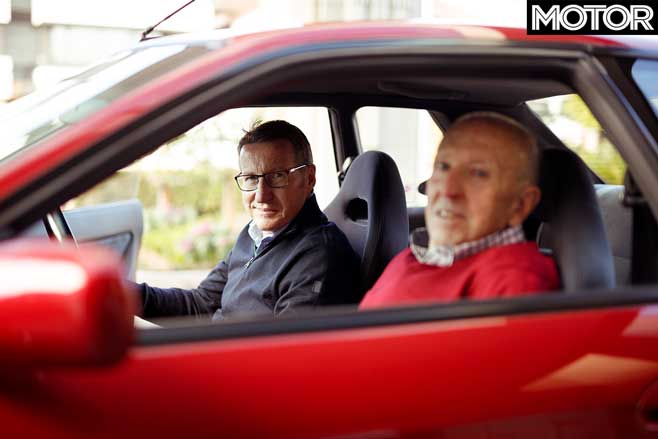
“I had one as a company car,” he says. “Freddie got me a car after I won the (1992) championship and then I ended up buying one. It was just the absolute gun car of the day. They had a really tough road presence about them. I had mine for many years before selling it. Of course, I should have kept it.”
Skaife’s GT-R roadie was a red pearl metallic version – what normal people would call maroon – which is the same hue as Nissan Australia’s original-patina collection car, which we brought along for the interview.
Skaifey took Gibbo for a nostalgic blat around Melbourne’s inner eastern suburbs and came back impressed.
“It’s pretty basic, but very sporty,” he said. “It was like an (E30) M3. It didn’t have all the creature comfort stuff, but it was very high-tech and phenomenally fast.
“The cornering was amazing, especially for the time. It’s still very impressive to drive now.”
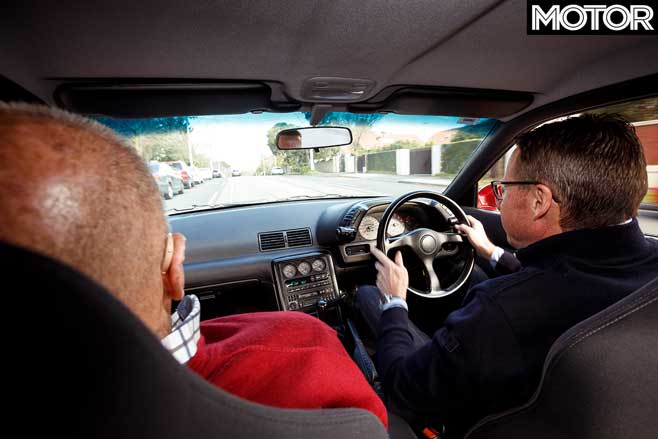
Amazingly, the all-conquering Aussie GT-R race cars were built from stripped road cars rather than bare bodyshells. “We nearly cried when we got the first three cars,” Gibson winces. “They were complete new road cars, and we had to pull them all apart and build them into race cars. All the stuff we had to throw away! We ripped them apart for the bodyshells.”
Gibson, Skaife and Beranger all bury their heads in their hands when they consider how much all those discarded parts would be worth now. The Aussie R32s – including the privateer version used by driver-turned-TV-talker Neil Crompton – all survive with collectors in period liveries.
When Skaife raced in Japan
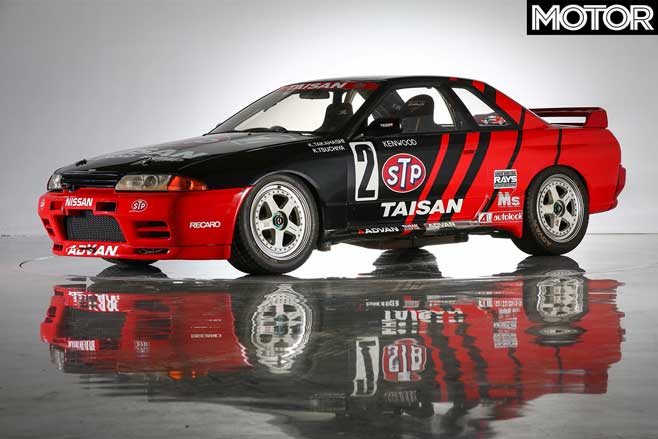
Mark Skaife found out just how good his locally produced Group A R32 GT-R was when he raced a Japanese customer car (pictured) in 1991.
While Gibson Motorsport had been ‘dissuaded’ by Nismo from entering races in Japan and Macau, Skaife secured drives with the semi-factory Taisan team, co-driving with Keiichi Tsuchiya. They finished third in the ’91 Fuji 500, but Skaife failed to finish the Guia classic at Macau.
He recalls that the exercise confirmed the superiority of the Australian-developed GT-R, which deviated so much from the Japanese version.
“It was good for us to go and drive because we actually ended up putting our (Australian Holinger) gearbox in it and a few other things.
“It highlighted just how good our car was in comparison. The difference was massive – (the Japanese car) was just not in the same league.”

So impressed was the Japanese team, it considered buying a Gibson car, but the move was blocked by Nismo.
“That would have shaken the establishment up,” Skaife smiles ruefully.
Australia’s category-killing Godzilla was the ultimate expression of Group A, the last international touring car category to rely on wild homologation special road cars. No four-wheel drive, computer-controlled Ford Sierra Cosworth RS500 or BMW M3 Evo would follow. Group A was replaced by 2.0-litre Super Touring, while Australia went with local V8s.

